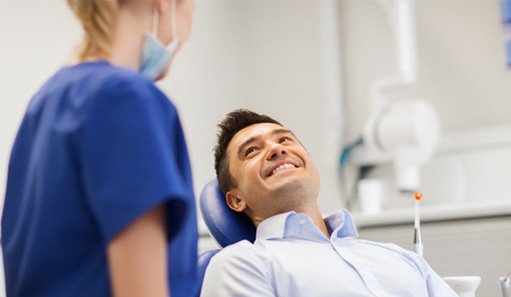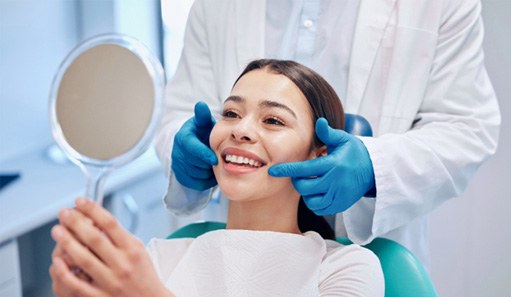Invisalign – Oshkosh, WI
Discreet, Fast, and Effective Treatment
Metal brackets and wires were once the only orthodontic solution available to individuals looking to straighten their smiles. Fortunately, Invisalign in Oshkosh offers patients a clear alternative that produces faster results. At Oshkosh Complete Dentistry, Dr. Heil and our team of experts can provide you with customized aligners designed to produce predictable results, offer greater comfort, and ensure optimal flexibility throughout treatment. To learn if you are an eligible candidate, contact us today to schedule a consultation.
How Does Invisalign Work?

Invisalign clear aligners are crafted using SmartTrack material that ensures a more comfortable fit while applying the appropriate amount of pressure to your teeth to ensure they shift in the right direction. These trays are discreet and capable of addressing overcrowding, gapped teeth, and misaligned bites. When worn the recommended 20-22 hours each day for 1-2 weeks at a time, you will discover your teeth becoming more properly aligned. As long as you swap out your trays for the next set in the series according to the timeline provided, you will experience no delays and enjoy a healthier, more beautiful smile in less time.
Indications for Invisalign

As one of the most versatile orthodontic treatments available today, Invisalign can fix a variety of problems, including:
Crowded Teeth
Crowded teeth are a common occurrence, and it can cause tooth decay, gum disease, and bad breath if left untreated. Because flossing and brushing are difficult when teeth overlap, Invisalign can help these teeth shift and create ample space or optimal oral health.
Gaps Between Teeth
Bite Alignment
If you suffer from an overbite, underbite, crossbite, or open bite, Invisalign can bring your smile back into alignment and decrease the possibility of chronic jaw pain and excessive wear and tear on your tooth enamel.
The Benefits of Invisalign

With so many orthodontic treatments to choose from, why choose Invisalign? Believe it or not, the answer is much more than just the discreet appearance of the trays. Below, you’ll find a few of the many reasons millions and millions of patients around the world have picked clear aligners.
Minimal Irritation

While traditional braces use brackets and wires to guide your teeth into proper alignment, Invisalign uses a different approach: clear aligners. Each tray is crafted from high-quality, low-profile, and smooth plastic to prevent soft tissue irritation. Plus, the chances of you experiencing this uncomfortable sensation are even lower since they are custom-made to fit the unique contours of your mouth perfectly.
Tip: If some soreness or discomfort does arise, you can always use dental wax!
Discreet Trays

It’s common for patients considering orthodontic treatment to be hesitant to commit because they don’t want to wear noticeable brackets and wires for 2-3 years. If you’re in the same boat, then you’ll be happy to know that Invisalign is equally as reliable and effective but completely see-through. In other words, the trays blend in with your teeth when worn, which makes them difficult to detect unless your friends, colleagues, and family members are making an effort to look for them.
Hassle-Free Dental Care

With Invisalign, you don’t need anything special to clean your teeth or your trays! In fact, your oral hygiene regimen will remain largely the same since all you need to do is take your aligners off in order to brush and floss as usual. As for your aligners, they only require lukewarm water, clear soap, and a soft-bristled toothbrush. On occasion, you can also use the cleaning crystals that came in your welcome kit, which can provide a deeper clean.
Fewer Follow-Ups

Usually, patients with traditional braces need to schedule adjustment appointments every four weeks. This might not seem like much of a time commitment at first, but it adds up over the course of 2-3 years. The good news is that the check-in visits with Invisalign are spaced out; they are typically every 6-8 weeks. That’s another reason patients – especially busy students and professionals – love this discreet orthodontic treatment.
No Dietary Restrictions

To help prevent broken brackets, loose wires, and the like, patients with traditional braces need to steer clear of all hard, crunchy, and sticky foods. If this is what’s been preventing you from moving forward with orthodontic treatment, then you’ll be happy to know that Invisalign doesn’t come with any dietary restrictions. The only thing you need to keep in mind is what’s best for your oral health, like enjoying foods and drinks with added sugar in moderation.
Shorter Average Treatment Time

We mentioned above that traditional braces can take 2-3 years, sometimes more. Conversely, the average treatment timeline with Invisalign is only 12-18 months! Plus, you’ll start to see the results much sooner since the aligners are clear.
Understanding the Cost of Invisalign

The cost associated with your Invisalign treatment is often the result of various factors, which is why we can’t give you an estimate of the cost here. We will, of course, provide you with a number at your consultation as well as review all of the ways you can make braces more affordable. In the meantime, keep reading to learn more on the topic of price!
Factors That Affect the Cost of Invisalign

To give you the most accurate figure during your consultation, we will first need to determine:
- The severity of your case (i.e., overcrowding, gapped teeth, misaligned bite)
- How many aligners you will need to achieve lasting results
- Whether you will be required to wear a top or bottom aligner, or both
- Any pre-Invisalign dental work (i.e., tooth extraction, periodontal therapy)
- The retainer you will be required to wear when finished with treatment
Another important factor is how well you follow the treatment guidelines, like wearing your aligners for the recommended amount of time. If you don’t, then we will need to make changes to your treatment plan, which may come with additional costs.
Invisalign vs. Mail-In Aligners: Which Costs More?

Over the years, several mail-order aligner companies have surfaced, attempting to replicate Invisalign treatment but for a fraction of the price. How? Well, they skip the initial consultation, rely on DIY impressions, and don’t have a licensed dental professional supervising the teeth-straightening process. That’s why so many patients have experienced worsened misalignment and even serious dental emergencies! Simply put, Invisalign will undoubtedly cost more, but it’s still absolutely worth the investment.
Does Dental Insurance Cover Invisalign?

Do you have dental insurance? If so, you’ll be happy to hear that most insurance companies will agree to pay at least a portion of the overall cost. Since we work with many of the nation’s leading providers, including Delta Dental Premiere, we will be here to file any necessary paperwork and claims on your behalf as well as answer any questions you have about your benefits. In other words, we will do everything we can to make utilizing your coverage a breeze!
Options for Making Invisalign Affordable

If you don’t have dental insurance, don’t let that stop you from finding out if Invisalign is right for you! If it is, then we will review the other financial solutions we offer, like flexible financing with CareCredit. This third-party financier allows you to space out your payments over the course of several months so you don’t have to pay for the entire cost of Invisalign at once. Want to learn more? Then contact us – we’re here to help!
Invisalign FAQs
Now you know a bit more about how Invisalign in Oshkosh works, the benefits this orthodontic treatment comes with, and who is a good fit. While reading over all this information is a great first step in determining if clear braces are right for you, it’s natural to still have a few questions on your mind. That’s why we’ve taken the time to respond to some of the most frequently asked ones below! If you can’t find the answer you are looking for or would simply prefer to speak directly with our team, don’t hesitate to get in touch.
Will Invisalign Affect My Speech?
To speak clearly, your tongue makes a series of distinct movements against the back of your teeth. So, when you initially put your clear aligners in, it’s normal to experience a slight lisp. However, many patients adjust to their trays seamlessly. Those that do have a bit of a learning curve can expedite the process by reading aloud and practicing the more difficult words repeatedly.
How Long Does Invisalign Treatment Take?
The answer to this question really depends on the issues you are looking to address. For example, correcting minor misalignment can take as little as six months. More complex cases on the other hand, like severe crowding, can take 18 months. So, while Invisalign’s average treatment timeline is only 12 months, it is always a good idea to schedule an initial consultation to learn how long the clear aligners need to deliver your smile goals.
How Do I Care For My Invisalign Aligners?
One of the biggest perks of opting for Invisalign is that the aligners are incredibly discreet. However, if you neglect to care for them properly, then their once clear appearance can take on a yellow, discolored look. To prevent that from happening, make sure to rinse them after you remove them from your mouth and again before putting them back in. Cleaning them daily with an Invisalign-friendly cleaner and toothbrush is also recommended. And, of course, always take them out when you are eating, drinking, or completing your oral hygiene routine.
What Should I Do If I Lose My Invisalign Trays?
If you accidentally misplace your aligners, don’t panic. After all, a frantic mind won’t help you find them any quicker! Instead, calmly retrace your steps, paying special attention to the small nooks and crannies that they could’ve fallen into. Once you’ve confirmed they are lost, contact our office. From there, we can provide you with the next best steps to ensure your treatment isn’t compromised. Under no circumstances should you attempt to remedy the situation on your own by wearing a previous set of trays or moving onto the next phase of treatment early.
If you are ready to enjoy a discreet, fast, effective treatment with Invisalign, we are here to help! Get in touch with our team to schedule your initial consultation. From there, you’ll be another step closer to your new and improved smile.
Is There Anything I Can’t Eat with Invisalign?
Technically, there aren’t any foods that you need to completely eliminate from your diet with Invisalign. There are, however, several foods you should avoid, like sour gummy candies and hard pretzels. Not only can these negatively impact your oral health, but they can also cause an attachment to come off. Simply put, it’s a good idea to continue to be mindful of what you’re eating so there aren’t any obstacles during your teeth-straightening journey.
Why Do I Need to Wear My Aligners for 20-22 Hours a Day?
For your teeth to move, you need to wear your aligners for 20-22 hours a day. If you consistently miss the mark, then you’ll fall off-track with your treatment plan. This has the potential to delay your results as well as require more of a monetary investment, which are two of many reasons why we encourage our patients to make an active effort to meet their wear time each and every day.
Tip: If you aren’t sure where to start, try designating a certain amount of time for each meal, like 40 minutes. In the process, use the stopwatch on your phone to see where adjustments are needed.
How Can I Avoid Losing or Damaging My Invisalign Aligners?
As we mentioned above, not wearing your aligners for the recommended amount of time can lead to several consequences, including treatment plan delays. For that reason, it’s important to do what you can to avoid losing or damaging your trays. The best thing to do is rinse them off and put them in their designated case when you aren’t wearing them (make sure to always put the case in the same place too!).
Note: Placing your trays on the table, wrapping them in a napkin, or leaving them out on the counter can lead to them getting thrown away or lost. So, don’t do that, even if it seems more convenient at the time!
Can I Drink Coffee with Invisalign?
You can, but only if you take your aligners out first. If you don’t, then your once-clear aligners will turn yellow or brown. Plus, there’s a risk of the residue from your coffee getting trapped against your teeth, increasing your risk of enamel erosion. That’s why we recommend enjoying this caffeinated beverage alongside your breakfast or lunch; your aligners will already be out!
What Happens After Invisalign?
Once your teeth are straight, our focus transitions to keeping them in their perfectly aligned positions. That involves a custom-made retainer. We’ll give you instructions on how often to wear it and how to maintain it so that it lasts for more than a year or two. Remember, orthodontic relapse can happen in the short or long term, so it’s important to make wearing your retainer a lifelong practice.
I Need a Checkup & Cleaning I am Looking for a Dentist for My Child I am Concerned about Bleeding Gums I am Concerned about Sleep Apnea I Have a Cavity or Broken Tooth I am Missing One or More Teeth I am Unhappy with My Smile I am Scared of the Dentist I am in Pain & Need Help View Our Services
